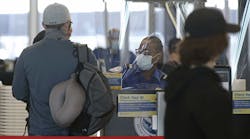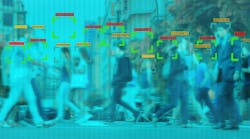Battle lines drawn over facial recognition technology as lawmakers revive proposed ban
A group of U.S. lawmakers has reintroduced a bill calling for a moratorium on the use of facial recognition technology by federal agencies, as digital rights advocates continue to cite civil liberties and privacy issues, as well as concerns facing marginalized populations.
The Facial Recognition and Biometric Technology Moratorium Act would ban the use of federal funds for biometric surveillance systems and information collected through biometric technology, including facial recognition, voice recognition and other biometric systems.
The legislation would also provide a private right of action for people whose biometric data is used in violation of the act, and permit states and localities to implement their own laws in using the technology.
‘Track Our Every Move’
Fight for the Future, the digital rights group behind BanFacialRecognition.com -- a coalition of dozens of organizations calling for an outright ban on law enforcement use of facial recognition – says there have been more cases of misidentification leading to wrongful arrest of black men and more surveillance of people exercising their right to protest.
They also allege databases of peoples’ most sensitive information have been breached, exposing irreplaceable data to bad actors; and that more government agencies, from the IRS to the TSA, have adopted facial recognition “to track our every move. We cannot afford to wait any longer to put this invasive technology in check, and any lawmaker who claims to care about privacy and justice must prove it by supporting this legislation.”
Fight for the Future is also calling to ban the corporate and private use of the technology on workers and the public, and has run campaigns to keep facial recognition out of music festivals, colleges, and retail stores.
Sen. Jeff Merkley, D-Ore., proposed the bill with Sens. Edward Markey, D-Mass.; Bernie Sanders, I-Vt.; Elizabeth Warren, D-Mass.; and Ron Wyden, D-Ore. The legislation was introduced in the House by Reps. Pramila Jayapal, D-Wash.; Ayanna Pressley, D-Mass.; and Rashida Tlaib, D-Mich., and several others.
SIA: Security is Improved
The Security Industry Association did not immediately respond to a request Thursday for comment on the legislation, but SIA released a lengthy statement last month when some of the same lawmakers sent a letter to the Transportation Security Administration strongly suggesting a moratorium be put in place on using facial recognition at security checkpoints.
SIA says facial recognition actually “provides enhanced security, accuracy and convenience for travelers without impacting existing privacy rights or expectations.
“Air travelers must already present valid ID at security checkpoints, which is subject to inspection for authenticity and checks against flight information. Additionally, TSA personnel compare the photo on each ID with the person presenting it for visual verification that they match.
“If one chooses to opt in to this completely voluntary biometric program, this additional step is automated at a kiosk. No personal passenger or identity information is retained. The technology is not used to “identify” or potentially “misidentify” a person – it simply verifies whether (or not) the photo of a person enrolled in the program matches their photo taken at the kiosk. Follow-up visual inspection by TSA personnel can address any issues that arise with the automated process.”
The SIA also pointed to public opinion research on facial recognition to date, which found nearly 70% of Americans support use of facial recognition for TSA screening.
Improving Efficiency
Silicon Valley.com carried a story this week noting that all three of the Bay Area's airports are deploying facial recognition technology, called Simplified Arrival, to screen incoming international passengers and testing it in San Jose to track some departing passengers.
It's catching imposters and processing travelers more efficiently — but also raising privacy concerns.
"You get instant verification," said James Hutton of U.S. Customs and Border Protection on a recent morning as hordes of bleary-eyed travelers streamed through San Francisco International Airport's immigration control booths and paused for a snapshot. "The camera does immediate identification," he said, "telling the customs officer that, 'This is the person that's in front of me.' "
The old approach we've long relied on — passport scanning and stamping — has vanished.
Instead, in a major overhaul of its strategy of processing travelers, government officials have installed cameras next to customs officers at all 238 international airports, 13 seaports and every pedestrian and bus processing facility along the nation's northern and southern land borders. The new technology was introduced at Bay Area airports in 2020 and completed at all ports of entry nationwide last June.
TSA agents are testing similar devices for departing flights at some security check-in lines at San Jose International Airport and others — a "curb to gate" approach that uses the passenger's face as a boarding pass, the SiliconValley.com reported.
"Your face is matched to the document that's tied to your reservation," easing the process of boarding passengers, said Hutton. "If we can verify that the person who went through TSA screening is the same person at the gate, you would never have to take your passport out of your pocket."
At the nation's borders, cameras started replacing self-serve passport kiosks in 2019 after a Congressional mandate, funded in 2016, directed the Department of Homeland Security to record the entry and exit of all foreign nationals.
The effort, first tested at pedestrian crossing lanes in San Ysidro, is intended to prevent terrorism and find people who overstay their visas.
The pandemic accelerated the technology’s adoption, offering a "touchless" way to process passengers. Officials don't have to scan a passport or clean a kiosk.
"This approach makes sense from a national security perspective," said Stephen Flynn, founding director of the Boston-based Global Resilience Institute at Northeastern University.
"Border control efforts at ports of entry have always been a needle-in-the-haystack challenge, given the volume, velocity and variety of people, conveyances and goods moving through the world's airports, seaports and border crossings."
But civil liberties and digital privacy groups said the technology represents a fundamental threat to privacy.
"We see this continual expansion of facial recognition into more and more areas of our lives. And we are giving in to it with the promise that it somehow will make our experience more convenient," said Albert Fox Cahn, executive director of the New York-based Surveillance Technology Oversight Project.
"Once you have someone's biometric information, you have it for life," he said. "You can change your credit card number. You can change your Social Security number. But you can never change your face. And so even if a program is only tracking our faces for one purpose today, it's creating the biometric infrastructure to track it — however agencies may want to — in future years."
Compared to fingerprinting, face-recognition technology poses a greater potential for growth into spy tools, critics say. That's because it can be used for surveillance through public video cameras — mapping a person's movement without their knowledge or consent.
Studies also suggest the technology is racially biased, with error rates rising significantly when applied to people of color, according to Jay Stanley, senior policy analyst with the ACLU Speech, Privacy, and Technology Project.
But The National Institute of Standards and Technology recently found that facial biometrics are nearly 99% accurate.
"That allows your officer to focus on questions: 'Why are you coming into the United States? What's the purpose of your trip? How long are you staying?' " said Hutton. "That interview doesn't get supplanted, but it makes the officer more efficient."
If you want your passport stamped, you can still request it. But most passengers are directed to an online site to get a copy of their arrival record.
The line-skipping system Global Entry also uses facial comparison technology.
If your photos don't match, the system reverts to the traditional process: Officials look at your face, ask you to swipe your passport and may require that you submit fingerprints. They may ask tougher questions: "Where did you go to school? What was your school mascot?"
Imposters Being Caught
Passport photos are almost impossible to manipulate because images are stored in a chip. Already the system has stopped around 1,800 "impostors" — someone using a stolen, borrowed or counterfeit passport — from entering the country, according to Hutton.
After scanning at entry, photos of U.S. citizens are deleted within 12 hours. Photos of foreign nationals are permanently stored in a secure U.S. Department of Homeland Security system.
Americans can opt out, asking an agent to verify their identity the original way. There are exemptions for minors under age 14 and elders over age 80.
But every foreign national is required to participate. They may also be asked for fingerprints if they've never entered the U.S. before.





